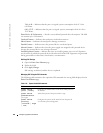
110 Configuring System Information
www.dell.com | support.dell.com
Configuring SNTP Settings
The switch supports the Simple Network Time Protocol (SNTP). SNTP assures accurate network
switch clock time synchronization up to the millisecond. Time synchronization is performed by a
network SNTP server. SNTP operates only as a client, and cannot provide time services to other
systems.
The switch can poll the following server types for the server time:
• Unicast
• Anycast
• Broadcast
Time sources are established by Stratums. Stratums define the accuracy of the reference clock.
The higher the stratum (where zero is the highest), the more accurate the clock. The switch
receives time from stratum 1 and above. The following is an example of stratums:
•
Stratum 0
— Indicates a real time clock is used as the time source, for example, a
GPS system.
•
Stratum 1
— Indicates that a server that is directly linked to a Stratum 0 time source is used.
Stratum 1 time servers provide primary network time standards.
•
Stratum 2
— Indicates that the time source is distanced from the Stratum 1 server over a
network path. For example, a Stratum 2 server receives the time over a network link, via NTP,
from a Stratum 1 server.
Information received from SNTP servers is evaluated based on the Time level and server type.
SNTP time definitions are assessed and determined by the following time levels:
•
T1
— The time at which the original request was sent by the client.
•
T2
— The time at which the original request was received by the server.
•
T3
— The time at which the server sent the client a reply.
•
T4
— The time at which the client received the server's reply.
The device can poll the following server types for the server time: Unicast, Anycast and Broadcast.
Polling for Unicast information is used for polling a server for which the IP address is known. SNTP
servers that are configured on the device are the only ones that are polled for synchronization
information. T1-T4 are used to determine server time. This is the preferred method for
synchronizing device time as it is most secure. If this method is selected, SNTP information is
accepted only from SNTP servers defined on the device using the
SNTP Servers
page.
Polling for Anycast information is used when the server IP address is unknown. If this method is
selected, all SNTP servers on the network can send synchronization information . The device is
synchronized when it proactively requests synchronization information. The best response (lowest
stratum) from the first 3 SNTP servers to respond to a request for synchronization information is
used to set the time value. Time levels T3 and T4 are used to determine the server time.


















